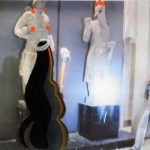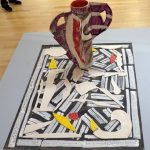"Things happen, and then they happen again, but not the same way, not quite; such is the logic of the biennial. And then there are things which have never happened before, and which happen now and in a time that seems somehow out of time, or takes our 'now' out with it." [hints]"Things happen, and then they happen again, but not in the same way, not quite; that's the logic of the biennial. And then there are things that have never happened before, and that happen to be happening now and in a time that somehow seems out of time, or that puts our 'now' out of it."[/hints]
This wrote reviewer Jeremy Millar[hints]Millar - in addition to being an artist - is a lecturer in 'Critical writing in Art and Design' at the Royal College of Art in London. When I did a quick internet search for reviews of the Liverpool Biennial 2016 shortly after the preview, his piece was 'all over the place'. As a reviewer, at least, he is well-equipped to build a quick internet presence with a text of his writing[/hints] about the Liverpool Biennial 2016. I liked the wording, which is why I like to quote him here. As a 'European' visitor, like Millar, I noticed that everything at this very international art event was still reeling from Brexit. All the official talk at the opening, two weeks after the referendum did give some attention to it, without emphasising that the population of Liverpool (about 465,500 inhab.) had voted in favour of 'staying in the EU' by some 58.2%.
Although it is still unclear what will happen with that outcome of the consultative referendum, it also influences the view with which I look at Liverpool itself and at this Biennale.
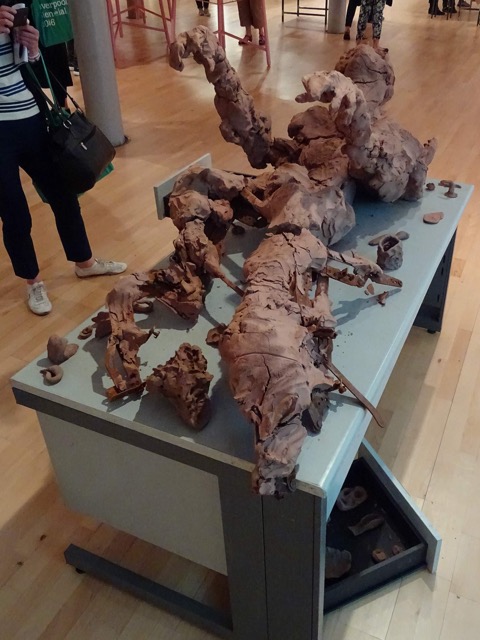
Destruction
I see a splintering world before me. Despite millions in European Community redevelopment funding, I still see an ugly, battered city. A city that the 'kaltstellung' by Margaret Thatcher for its rebellious role against her policies still does not seem to have been overcome. Also a city on which, during World War II, the German Luftwaffe carried out a total of 80 bombings, destroying 50% of the city some 2,500 residents lost their lives. This so interfered with the city's structure that it still appears to be torn apart. The current architecture is a stark confrontation between what once was and what is to come of it. Seemingly without a sense of direction.
Slave trade
In the early 18th century, 40 per cent of world trade passed through the port of Liverpool. Liverpudlian shipowners were responsible for possibly as much as 80% of the slave trade carried out by the British between 1740 and 1840. This made Liverpool shipowners the major players in the transatlantic slave trade. From Liverpool, more than 5,300 transatlantic sailings were carried out and more than 1.5 million slaves were moved on the so-called 'triangle sailing route' from West Africa to the Caribbean and the Americas. Some 20 to 25% of the slaves so transported died before they reached their destination.
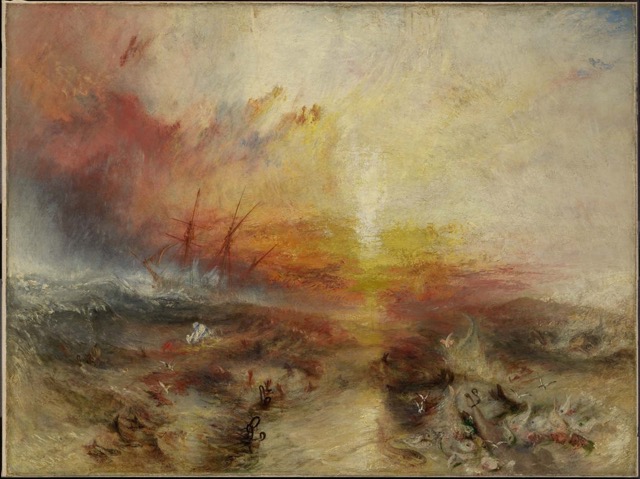
Neoclassical Architecture
In my view, the slave trade was an abomination of a dark period that nevertheless brought great wealth to Liverpool. This in turn led to a building boom in Neoclassical architecture that was to rival the Greek and Roman example. Liverpool as a second version of Ancient Greece or the ancient city-state of Carthage. Despite the devastating bombing in World War II, numerous remnants of this can also be found in the city.
Slavery museum and Beatles
On 23 August 2007 in Liverpool - on the occasion of the Slavery Commemoration, the Slavery Museum opened its doors right here. It is an attempt at greater openness about that dark, pitch-black time in the eighteenth century. That day marked the 200th anniversary of the abolition of the slave trade in Britain and, ironically, the 800th anniversary of Liverpool itself. The following year, Liverpool was European Capital of Culture, along with Luxembourg. Besides all this, Liverpool was, of course, the centre of the 'Mersey Beat' in the 1960s: 'all the Beatles were born in Liverpool'.
With this introduction, you might understand better, why I find Jeremy Millar's opening so apt when talking about our time, the 'now' and Liverpool. And, of course, about that Biennale.
3×3 Shades of Storytelling
Thematically, it is not easy to find direction in the 9th edition of the Liverpool Biennial. The art event lacks a singular title or a single coherent theme. There is a structure of six self-contained 'episodes'. All of which may be needed to tell the stories (we are, of course, talking about storytelling) to be made possible. Moreover, a very diverse bunch of artists had to be accommodated: 37 artists, duos and collectives, spread across 26 venues.
In the words of Biennale director Sally Tallant, 'fiction, stories, and histories are explored, taking visitors on a series of journeys through space and time, relating to Liverpool's past, present and future.' An 11-member team of curators has thus translated this into a format of six 'episodes'; Ancient Greece, Chinatown, Children, Software, 'Monuments to the Future' and Flashback.
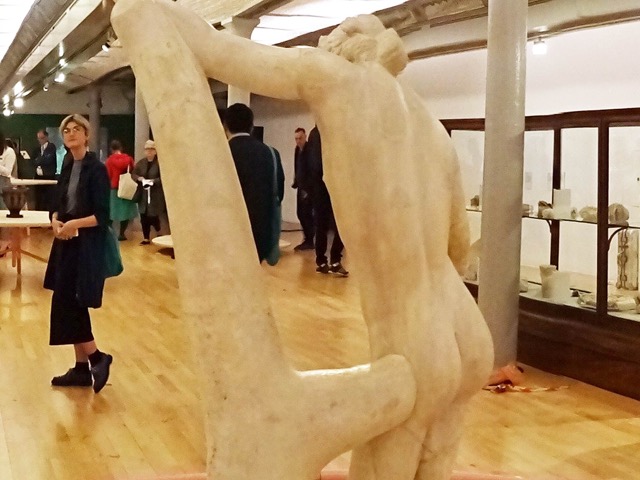
Grabbelton
While I like the choice of stories linked to places, it is also unoriginal. Add in 6 'episodes' and it becomes so broad that it again seems pointless. After all: does a place without a story or history even exist?
To make everything even more confusing, the different 'chapters' or 'episodes' intertwine through the different locations. In doing so, they sometimes seem to reinforce each other but sometimes work against each other. During the viewing, I experienced it as a pointless exercise that, instead of clarifying, obscures and confuses. This is also because the works of the artists involved do not seem to unambiguously conform to this fragmentary division. Marvel then reveals that the works brought together either alone or together tell their own story, but the sense of a grab-bag that occasionally leads to wonder lingers.
Cains Brewery
I experienced this most strongly in the main hall of the former Cains Brewery. This place hung with rich history whose front building is built with allure from red brick, has a soulless modern industrial hall at the back. In this shabby hall, a structure has been erected as a new exhibition building named 'Collider' by Andreas Angelidakis. This polygonal structure has a circular arena at its centre. 'Collider' refers to the particle accelerator near Geneva (CERN in Switzerland). Other structures have been built in and around this object. On the walls, in the central middle section, in the hall around it, work by various artists has been set up 'here and there'. Sometimes those objects and works connect with the structure set up by Angelidakis, sometimes they seem to deny that structure and experience it as a nuisance.
Artists who have found a place here, in turn, come from the various 'episodes'. "Do you know, do I know", I would almost sigh. It's a shaky and messy bunch with works by Céline Condorelli, the trio Ramin Haerizadeh, Rokni Haerizadeh and Hesam Rahmanian (both objects and video work), Audrey Cottin (Flourtables), Ian Cheng (Emissary Forks For You), Lara Favaretto's (Lost and Found suitcases), Rita McBride (Objects Perfiles), Jason Dodge (What the Living Do), Samson Kambalu (video) , Yin-Ju Chen (Extrastellar Evaluations), Marvin Grays Chetwynd (film Dogsy Ma Bone, worked out with children, inspired by a 1936 Betty Boop song, A Song A Day). Next up is work by Betty Woodman (Kinmono Ladies - ceramics and textiles) and Sahej Rahal.
Tate Liverpool
Opposite the display at Cains Brewery, there is the exhibition at Tate Liverpool. That is also where the biennial's information centre is located, and so I also see the Tate Liverpool as a starting point for visitors. The exhibition here on the first floor is part of the "Ancient Greece" episode.
Here, the antiquities collection of the National Liverpool Museum, the archaeological antiquities collection of Ince Blundell are brought together with works by contemporary artists. Here, the form of presentation is museum-like in character, and despite the mixing, the exhibition therefore remains uncluttered. Here, it managed to create an atmosphere in which the works question, complement or reinforce each other.
Here, the fragmented aspect of the formula chosen by the curators works implicitly or 'inclusive'. The antiquities in 'Ince Blundell Collection', are mostly fragments of statues or sculptures that are themselves composed of various fragments. As a result, they look almost postmodern. The looming fragmentation forms a bridge to the contemporary works on display. These works are by the artists: Koenraad Dedobbeleer (display structures), Andreas Angelidakis (video), Jumans Manna (video), Betty Woodman (mural piece), Lawrence Abu Hamdan (video Double Take), Jason Dodge, Samson Kambalu and Sahej Rahal.
What the Living Do
Jason Dodge's 'What the Living Do', spread throughout the biennial, is made up of collected fragments, petty rubbish that people carelessly leave behind: candy wrappers, cigarette butts, spent train tickets, note cards, empty mini drink bottles, packaging of snacks, fallen leaves and shells.
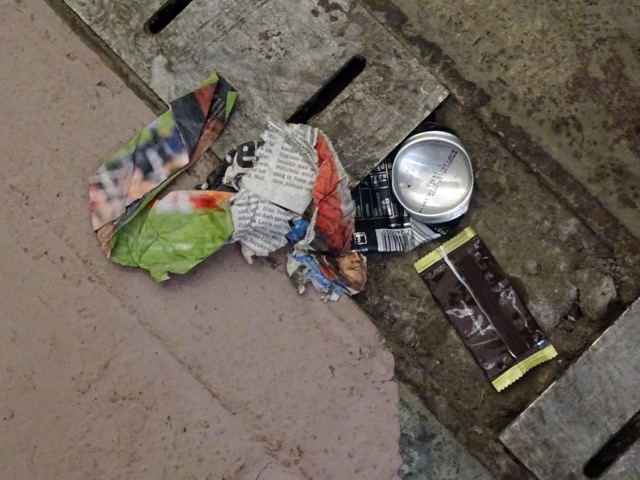
In other places this chafes less than here on the exhibition hall floor, where this work adds something to the overall fragmentation. The scraps and clutter just stand out from the 'real' mess in urban space, which you have gradually learned to ignore. Here, it enters the museum like an inevitable tsunami. No other work is as out of place in this biennial as Jason Dodge's.
Betty Woodman
Set against the out-of-control and fragmented work in this biennial is Betty Woodman (1930). She makes extremely measured work that she builds up from two-dimensional painting, ceramic plates and three-dimensional objects. For me, this artist, a grande dame whose artistic career began in 1950 and who thus carries with her a working period of more than 65 years, is the lost star in this somewhat crumbly whole.
Definitely going to watch
The Liverpool Biennial 2016 is a massive art project. You certainly don't do that in a day. It's a good excuse, with all the renewed interest in the 'Britains', to take a trip to Liverpool. Combine it with your other hobbies. Were you already a John, Paul, Ringo and George fan, but never got around to it? Do it now and discover the city of the Mersey Beat, with its stories and histories!
Besides the biennial's main programme with its outdoor and indoor venues (26), partner exhibitions include the 'John Moores Painting Prize 2016' at the Walker Art Gallery (A highly respectable prize for painting that has been around since 1957) and the equally respectable 'Bloomberg New Contemporaries 2016' that offers 46 young artists a stage at Bluecoat. A full programme of tours, talks, workshops, films, performances, conferences and symposia. All worth visiting until 16 October 2016.


